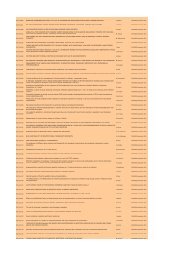Profilaksa DVT kod velikih ortopedskih operacija - Depol ...
Profilaksa DVT kod velikih ortopedskih operacija - Depol ...
Profilaksa DVT kod velikih ortopedskih operacija - Depol ...
You also want an ePaper? Increase the reach of your titles
YUMPU automatically turns print PDFs into web optimized ePapers that Google loves.
20 - 22 September 2012, Opatija, Croatia<br />
OSTEOGENIC POTENTIAL AND STEMNESS OF MESENCHYMAL<br />
STEM CELLS AFTER DEXAMETHASONE TREATMENT<br />
Andreja Vukasovic, Department of Histology and Embryology, School of Medicine, University of Zagreb,<br />
Zagreb, Croatia<br />
Davor Jezek, Department of Histology and Embryology, School of Medicine, University of Zagreb, Zagreb,<br />
Croatia<br />
Petar Kostesic, Clinic for Surgery, Orthopedics and Ophthalmology, Faculty of Veterinary Medicine,<br />
University of Zagreb, Zagreb, Croatia<br />
Damir Hudetz, Department of Orthopedics, University Hospital Sveti Duh, Zagreb, Croatia<br />
Ivan Cerovecki, School of Medicine, University of Zagreb, Zagreb, Croatia<br />
Marin Kosovic, Department of Physics and Biophysics, School of Medicine, University of Zagreb, Zagreb,<br />
Croatia<br />
Tadija Petrovic, Clinic for Traumatology, Clinical Hospital Center “Sestre Milosrdnice”, Zagreb, Croatia<br />
Drazen Maticic, Clinic for Surgery, Orthopedics and Ophthalmology, Faculty of Veterinary Medicine,<br />
University of Zagreb, Zagreb, Croatia<br />
Alan Ivkovic, Department of Orthopedics, University Hospital Sveti Duh, Zagreb, Croatia<br />
Marko Pecina, School of Medicine, University of Zagreb, Zagreb, Croatia<br />
The purpose of the research was to improve osteogenic differentiation of human bone marrow derived-mesenchymal<br />
stem cells (hMSCs) and to evaluate the level of remaining undifferentiated stem cells in culture. Standard<br />
cell culture protocol includes continuous exposure to the dexamethasone which is not easy to reproduce in human<br />
body. Therefore, our experiment was designed to investigate the possibility of using short-term dexamethasone<br />
exposure in order to induce osteogenic differentiation.<br />
Human bone marrow-derived MSCs were expanded with FGF-2 supplemented media. Afterwards cells were cultured<br />
in osteogenic media (DMEM low glucose, 10% FBS, 10mM β-glycerophosphate, 5µg/ml ascorbic acid, 1mM<br />
piruvat) and treated with different concentrations of dexamethasone, both short-term and continuous. The differentiation<br />
status of the cells was estimated using several osteogenic markers - alkaline phosphatase (AP) activity,<br />
the bone sialoprotein (BSP) and dentin matrix protein 1 (DMP-1) mRNAs. The stemness of the cells was estimated<br />
by the presence of pluripotency markers - SRY (sex determining region Y)-box 2 (SOX2) and octamer-binding transcription<br />
factor 4 (OCT4). The measurements were conducted on the days 7 and 14 after osteogenic conditions<br />
had been introduced.<br />
Our results show that continuous treatment induces the highest level of osteogenesis, but 2 hour exposure also induced<br />
differentiation in comparison with control. Overall, 10-5 M concentration of dexamethasone was the most<br />
powerful in the short-term induction of osteogenesis. SOX2 has not been detected in hMSCs. OCT4 was expressed<br />
in undifferentiated pluripotent hMSCs and its expression subsequently went down, indicating that the differentiation<br />
process is proceeding.<br />
Poster<br />
91




